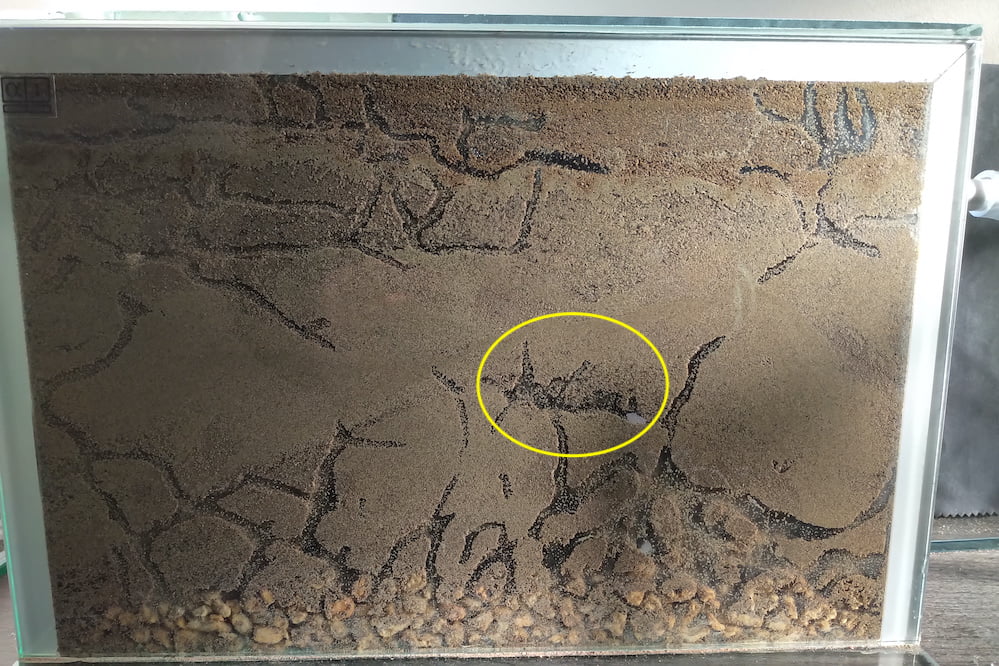Hello, and welcome to another update on my captive ant colony journals. I had not posted an update last week as there had not been much activity. Instead, I wrote an article about the evolution of ants. To be honest, there is not much activity still. However, here is an update on all three colonies. Lasius niger, Lasius umbratus, and Myrmica rubra.
Lasius niger
There have been no new additions to the Lasius niger family over the past couple of weeks, though a small pile of 20 or so larvae are still present. The workers have been staying in the nest, with only ever one or two ants out foraging at any one time. However, all is looking well with the ants, their brood and queen.
The ants have yet to discover the nesting box that I attached to their foraging box some weeks ago. There have been a few occasions when a lone worker would find the stick that leads to the tubing that connects the foraging box to the nesting box. Yet they always seem to turn about when they reach the entrance to the tubing. Perhaps the ants are teasing me.
I could attach the test tube directly to the nesting box port, but I do not wish to do that. I prefer the ants to discover the nesting box in their own time.
Lasius umbratus
Next up in my captive ant colony journals, is my oldest colony. Still, the excavation of the new nest continues, with no signs of the ants preparing to move in. However, looking into the nesting box I can see that the ants are now creating a large chamber near the deeper part of the nesting box, where the soil meets the clay pebbles.
The number of ants that are engaged in the excavation stays low. Only a dozen or so ants constantly carrying out the work.
Inside the current nesting box, I can see brood and workers in the various chambers. There is not a great deal of activity in the nest at this moment in time. However, it has been quite cold in the Ant Room (averaging on 12*C). Saying that, though, when the sun rises, and it if it a cloudless day, the Ant Room, which is south facing, does get warm. Sometimes it reaches 23+*C in the winter! I can quite imagine that the poor ants are confused as to whether it is winter or summer. Is it time to hibernate or is it time to go outside? I wish we humans could hibernate.

Myrmica rubra
Last week, when I investigated the Myrmica rubra nest, I noticed that the soil was looking dry. I carefully removed the lid – thankfully, there were no ants there – and examined the soil more closely. I found it to be very dry indeed. Knowing that Myrmica rubra do not like it too dry, I added some water, very carefully. It took a few hours for the water to soak into the entire nest. I added the water cautiously, as I did not want a sudden flood racing into the tunnels and chambers. I added the water in at the opposite end of the nesting box to where the nest entrance was. Some water did flow into the nest via the entrance. However, it was only a little and caused the ants no distress.
Today I peeked into the nest. Normally, when I do this the Myrmica rubra ants do not react very much unless I keep the covering off for too long. However, today, when I lifted the box cover, they at once went into aggression mode. They were running about with their mandibles wide open, looking for something to sting. I quickly replaced the covers. All looked well within the nest.
Thank you for reading this update to my captive ant colony journals. I hope you found it to be interesting, even though there was not much to report. Feel free to comment if you wish, or if you wish to ask a related question. Please be aware that I moderate all comments before they appear live. I always endeavour to read your comment as soon as I can. Please also be aware that if your post has any links or ads, it is automatically rejected as spam.